child seat Alfa Romeo 166 2006 Owner handbook (in English)
[x] Cancel search | Manufacturer: ALFA ROMEO, Model Year: 2006, Model line: 166, Model: Alfa Romeo 166 2006Pages: 272, PDF Size: 4.17 MB
Page 8 of 272
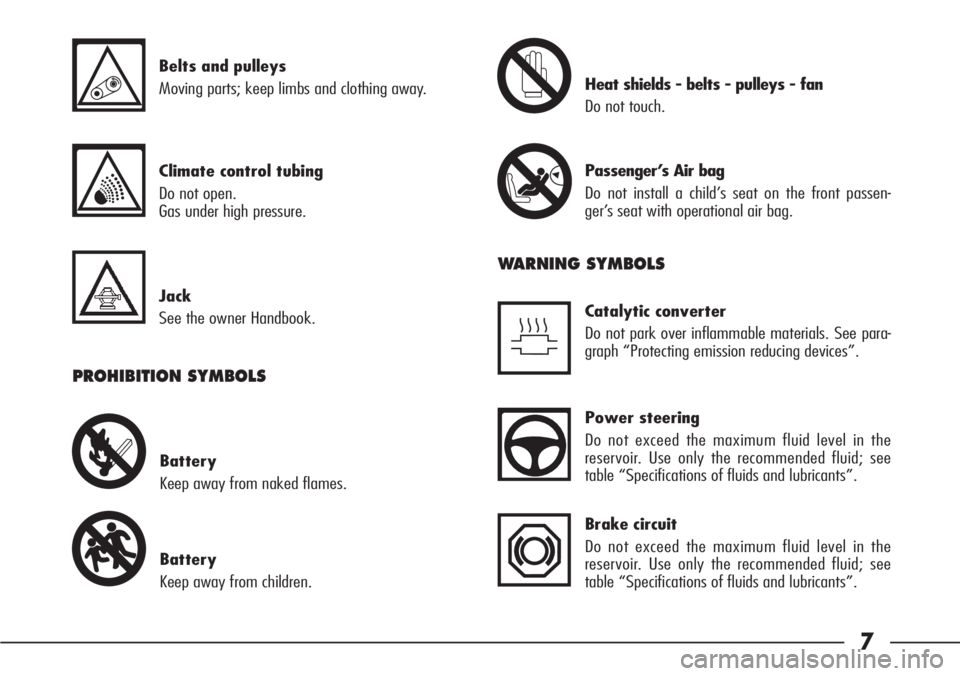
WARNING SYMBOLS
Power steering
Do not exceed the maximum fluid level in the
reservoir. Use only the recommended fluid; see
table “Specifications of fluids and lubricants”.
Brake circuit
Do not exceed the maximum fluid level in the
reservoir. Use only the recommended fluid; see
table “Specifications of fluids and lubricants”. Catalytic converter
Do not park over inflammable materials. See para-
graph “Protecting emission reducing devices”. Belts and pulleys
Moving parts; keep limbs and clothing away.
Jack
See the owner Handbook.
Climate control tubing
Do not open.
Gas under high pressure.
PROHIBITION SYMBOLS
Battery
Keep away from children. Battery
Keep away from naked flames.
Heat shields - belts - pulleys - fan
Do not touch.
AIRBAG
Passenger’s Air bag
Do not install a child’s seat on the front passen-
ger’s seat with operational air bag.
7
Page 12 of 272
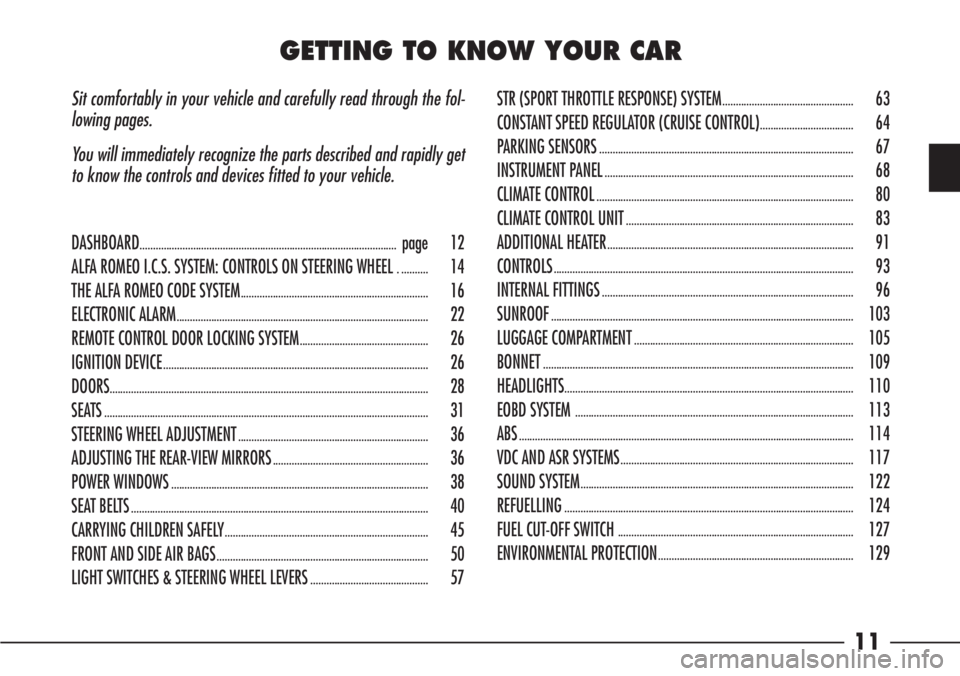
11
Sit comfortably in your vehicle and carefully read through the fol-
lowing pages.
You will immediately recognize the parts described and rapidly get
to know the controls and devices fitted to your vehicle.STR (SPORT THROTTLE RESPONSE) SYSTEM.................................................63
CONSTANT SPEED REGULATOR (CRUISE CONTROL)
...................................64
PARKING SENSORS
...............................................................................................67
INSTRUMENT PANEL
.............................................................................................68
CLIMATE CONTROL
................................................................................................80
CLIMATE CONTROL UNIT
.....................................................................................83
ADDITIONAL HEATER
............................................................................................91
CONTROLS
................................................................................................................93
INTERNAL FITTINGS
..............................................................................................96
SUNROOF
.................................................................................................................103
LUGGAGE COMPARTMENT
..................................................................................105
BONNET
....................................................................................................................109
HEADLIGHTS
............................................................................................................110
EOBD SYSTEM
........................................................................................................113
ABS
.............................................................................................................................114
VDC AND ASR SYSTEMS
.......................................................................................117
SOUND SYSTEM
......................................................................................................122
REFUELLING
............................................................................................................124
FUEL CUT-OFF SWITCH
........................................................................................127
ENVIRONMENTAL PROTECTION
.........................................................................129 DASHBOARD
................................................................................................page 12
ALFA ROMEO I.C.S. SYSTEM: CONTROLS ON STEERING WHEEL
. ..........14
THE ALFA ROMEO CODE SYSTEM
......................................................................16
ELECTRONIC ALARM
..............................................................................................22
REMOTE CONTROL DOOR LOCKING SYSTEM
................................................26
IGNITION DEVICE
...................................................................................................26
DOORS
.......................................................................................................................28
SEATS
.........................................................................................................................31
STEERING WHEEL ADJUSTMENT
.......................................................................36
ADJUSTING THE REAR-VIEW MIRRORS
..........................................................36
POWER WINDOWS
................................................................................................38
SEAT BELTS
...............................................................................................................40
CARRYING CHILDREN SAFELY
............................................................................45
FRONT AND SIDE AIR BAGS
...............................................................................50
LIGHT SWITCHES & STEERING WHEEL LEVERS
............................................57
GETTING TO KNOW YOUR CAR
Page 31 of 272
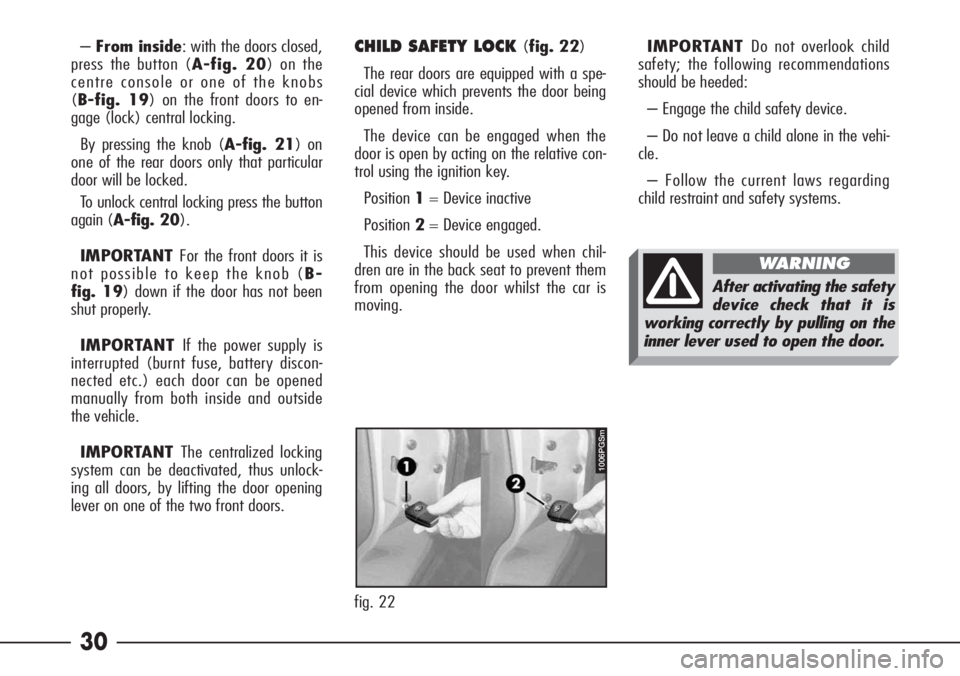
30
–From inside: with the doors closed,
press the button (A-fig. 20) on the
centre console or one of the knobs
(B-fig. 19) on the front doors to en-
gage (lock) central locking.
By pressing the knob (A-fig. 21) on
one of the rear doors only that particular
door will be locked.
To unlock central locking press the button
again (A-fig. 20).
IMPORTANT For the front doors it is
not possible to keep the knob (B-
fig. 19) down if the door has not been
shut properly.
IMPORTANT If the power supply is
interrupted (burnt fuse, battery discon-
nected etc.) each door can be opened
manually from both inside and outside
the vehicle.
IMPORTANT The centralized locking
system can be deactivated, thus unlock-
ing all doors, by lifting the door opening
lever on one of the two front doors.CHILD SAFETY LOCK (fig. 22)
The rear doors are equipped with a spe-
cial device which prevents the door being
opened from inside.
The device can be engaged when the
door is open by acting on the relative con-
trol using the ignition key.
Position1= Device inactive
Position2= Device engaged.
This device should be used when chil-
dren are in the back seat to prevent them
from opening the door whilst the car is
moving.IMPORTANT Do not overlook child
safety; the following recommendations
should be heeded:
– Engage the child safety device.
– Do not leave a child alone in the vehi-
cle.
– Follow the current laws regarding
child restraint and safety systems.
After activating the safety
device check that it is
working correctly by pulling on the
inner lever used to open the door.
WARNING
fig. 22
1006PGSm
Page 45 of 272
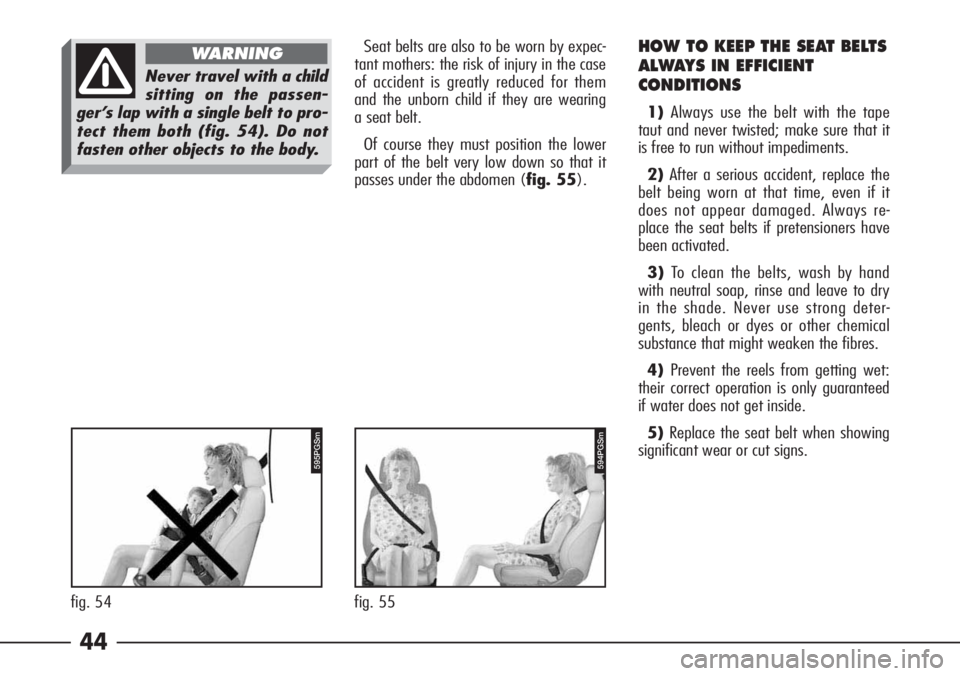
44
Seat belts are also to be worn by expec-
tant mothers: the risk of injury in the case
of accident is greatly reduced for them
and the unborn child if they are wearing
a seat belt.
Of course they must position the lower
part of the belt very low down so that it
passes under the abdomen (fig. 55).HOW TO KEEP THE SEAT BELTS
ALWAYS IN EFFICIENT
CONDITIONS
1)Always use the belt with the tape
taut and never twisted; make sure that it
is free to run without impediments.
2)After a serious accident, replace the
belt being worn at that time, even if it
does not appear damaged. Always re-
place the seat belts if pretensioners have
been activated.
3)To clean the belts, wash by hand
with neutral soap, rinse and leave to dry
in the shade. Never use strong deter-
gents, bleach or dyes or other chemical
substance that might weaken the fibres.
4)Prevent the reels from getting wet:
their correct operation is only guaranteed
if water does not get inside.
5)Replace the seat belt when showing
significant wear or cut signs.
Never travel with a child
sitting on the passen-
ger’s lap with a single belt to pro-
tect them both (fig. 54). Do not
fasten other objects to the body.
WARNING
595PGSm
fig. 54
594PGSm
fig. 55
Page 46 of 272
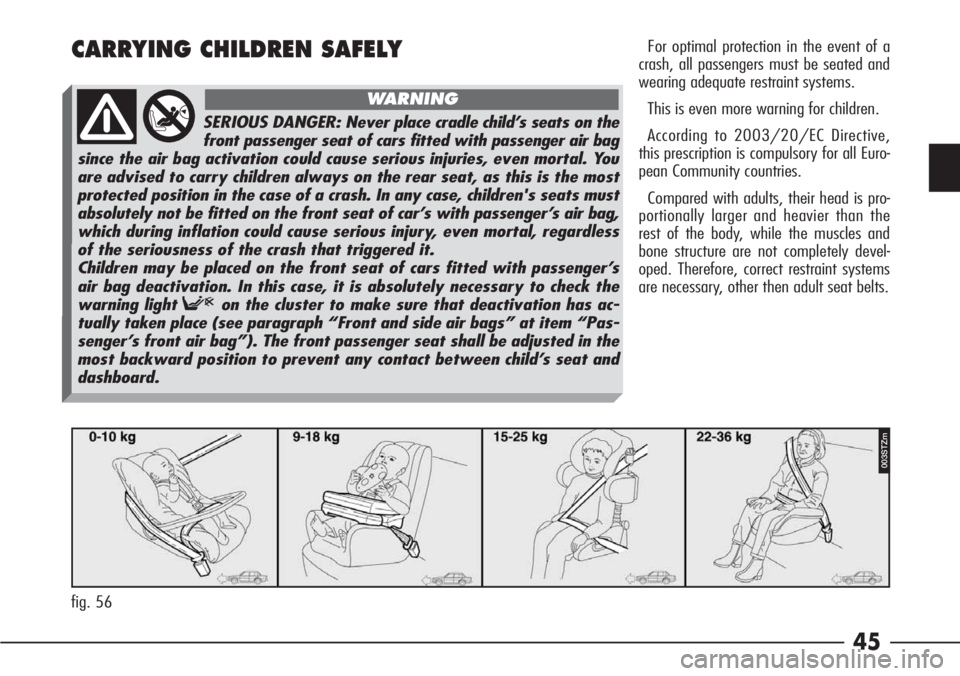
45
CARRYING CHILDREN SAFELYFor optimal protection in the event of a
crash, all passengers must be seated and
wearing adequate restraint systems.
This is even more warning for children.
According to 2003/20/EC Directive,
this prescription is compulsory for all Euro-
pean Community countries.
Compared with adults, their head is pro-
portionally larger and heavier than the
rest of the body, while the muscles and
bone structure are not completely devel-
oped. Therefore, correct restraint systems
are necessary, other then adult seat belts.
fig. 56
003STZm
SERIOUS DANGER: Never place cradle child’s seats on the
front passenger seat of cars fitted with passenger air bag
since the air bag activation could cause serious injuries, even mortal. You
are advised to carry children always on the rear seat, as this is the most
protected position in the case of a crash. In any case, children's seats must
absolutely not be fitted on the front seat of car’s with passenger’s air bag,
which during inflation could cause serious injury, even mortal, regardless
of the seriousness of the crash that triggered it.
Children may be placed on the front seat of cars fitted with passenger’s
air bag deactivation. In this case, it is absolutely necessary to check the
warning light
Fon the cluster to make sure that deactivation has ac-
tually taken place (see paragraph “Front and side air bags” at item “Pas-
senger’s front air bag”). The front passenger seat shall be adjusted in the
most backward position to prevent any contact between child’s seat and
dashboard.
AIRBAGWARNING
Page 47 of 272
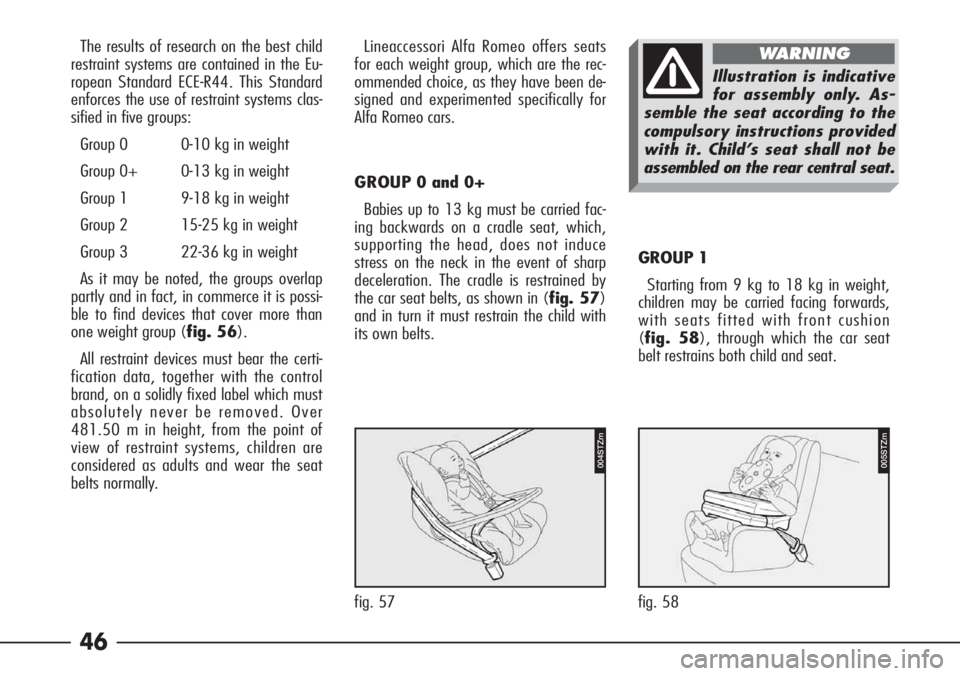
46
The results of research on the best child
restraint systems are contained in the Eu-
ropean Standard ECE-R44. This Standard
enforces the use of restraint systems clas-
sified in five groups:
Group 0 0-10 kg in weight
Group 0+ 0-13 kg in weight
Group 1 9-18 kg in weight
Group 2 15-25 kg in weight
Group 3 22-36 kg in weight
As it may be noted, the groups overlap
partly and in fact, in commerce it is possi-
ble to find devices that cover more than
one weight group (fig. 56).
All restraint devices must bear the certi-
fication data, together with the control
brand, on a solidly fixed label which must
absolutely never be removed. Over
481.50 m in height, from the point of
view of restraint systems, children are
considered as adults and wear the seat
belts normally.Lineaccessori Alfa Romeo offers seats
for each weight group, which are the rec-
ommended choice, as they have been de-
signed and experimented specifically for
Alfa Romeo cars.
GROUP 0 and 0+
Babies up to 13 kg must be carried fac-
ing backwards on a cradle seat, which,
supporting the head, does not induce
stress on the neck in the event of sharp
deceleration. The cradle is restrained by
the car seat belts, as shown in (fig. 57)
and in turn it must restrain the child with
its own belts.GROUP 1
Starting from 9 kg to 18 kg in weight,
children may be carried facing forwards,
with seats fitted with front cushion
(fig. 58), through which the car seat
belt restrains both child and seat.
004STZm
fig. 57 fig. 58
005STZm
Illustration is indicative
for assembly only. As-
semble the seat according to the
compulsory instructions provided
with it. Child’s seat shall not be
assembled on the rear central seat.
WARNING
Page 48 of 272
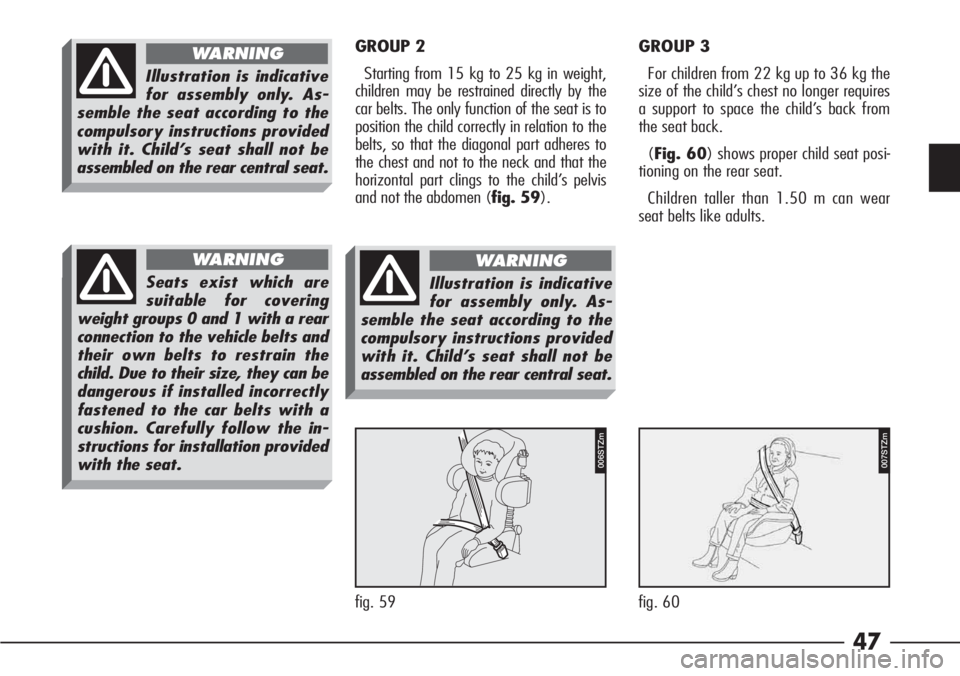
47
GROUP 2
Starting from 15 kg to 25 kg in weight,
children may be restrained directly by the
car belts. The only function of the seat is to
position the child correctly in relation to the
belts, so that the diagonal part adheres to
the chest and not to the neck and that the
horizontal part clings to the child’s pelvis
and not the abdomen (fig. 59).GROUP 3
For children from 22 kg up to 36 kg the
size of the child’s chest no longer requires
a support to space the child’s back from
the seat back.
(Fig. 60) shows proper child seat posi-
tioning on the rear seat.
Children taller than 1.50 m can wear
seat belts like adults.
006STZm007STZm
fig. 59 fig. 60
Seats exist which are
suitable for covering
weight groups 0 and 1 with a rear
connection to the vehicle belts and
their own belts to restrain the
child. Due to their size, they can be
dangerous if installed incorrectly
fastened to the car belts with a
cushion. Carefully follow the in-
structions for installation provided
with the seat.
WARNING
Illustration is indicative
for assembly only. As-
semble the seat according to the
compulsory instructions provided
with it. Child’s seat shall not be
assembled on the rear central seat.
WARNING
Illustration is indicative
for assembly only. As-
semble the seat according to the
compulsory instructions provided
with it. Child’s seat shall not be
assembled on the rear central seat.
WARNING
Page 49 of 272
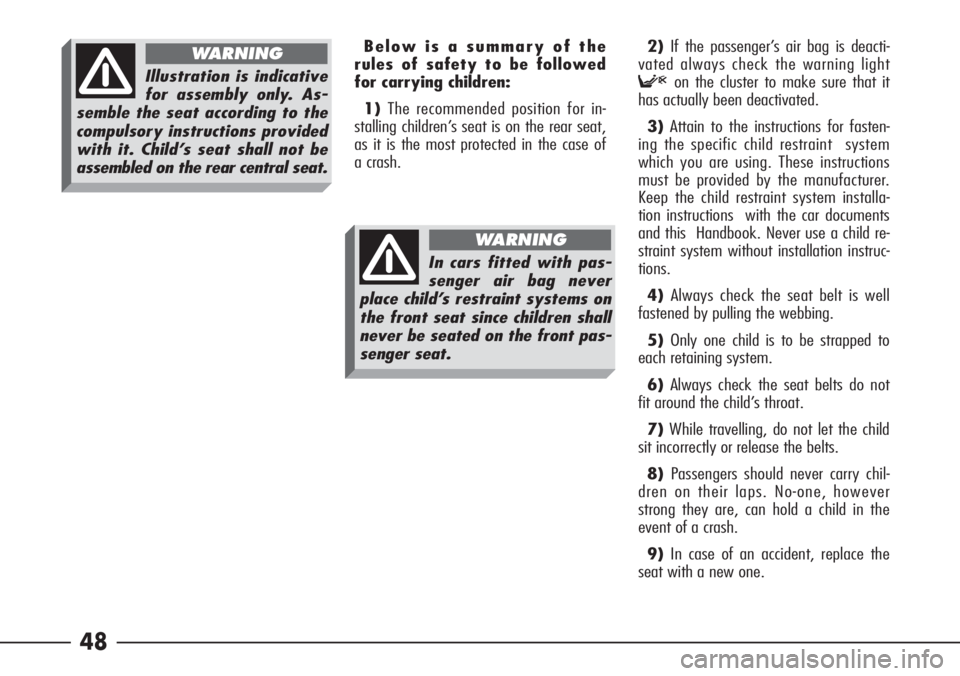
48
Below is a summary of the
rules of safety to be followed
for carrying children:
1)The recommended position for in-
stalling children’s seat is on the rear seat,
as it is the most protected in the case of
a crash.2)If the passenger’s air bag is deacti-
vated always check the warning light
Fon the cluster to make sure that it
has actually been deactivated.
3)Attain to the instructions for fasten-
ing the specific child restraint system
which you are using. These instructions
must be provided by the manufacturer.
Keep the child restraint system installa-
tion instructions with the car documents
and this Handbook. Never use a child re-
straint system without installation instruc-
tions.
4)Always check the seat belt is well
fastened by pulling the webbing.
5)Only one child is to be strapped to
each retaining system.
6)Always check the seat belts do not
fit around the child’s throat.
7)While travelling, do not let the child
sit incorrectly or release the belts.
8)Passengers should never carry chil-
dren on their laps. No-one, however
strong they are, can hold a child in the
event of a crash.
9)In case of an accident, replace the
seat with a new one.
In cars fitted with pas-
senger air bag never
place child’s restraint systems on
the front seat since children shall
never be seated on the front pas-
senger seat.
WARNING
Illustration is indicative
for assembly only. As-
semble the seat according to the
compulsory instructions provided
with it. Child’s seat shall not be
assembled on the rear central seat.
WARNING
Page 50 of 272
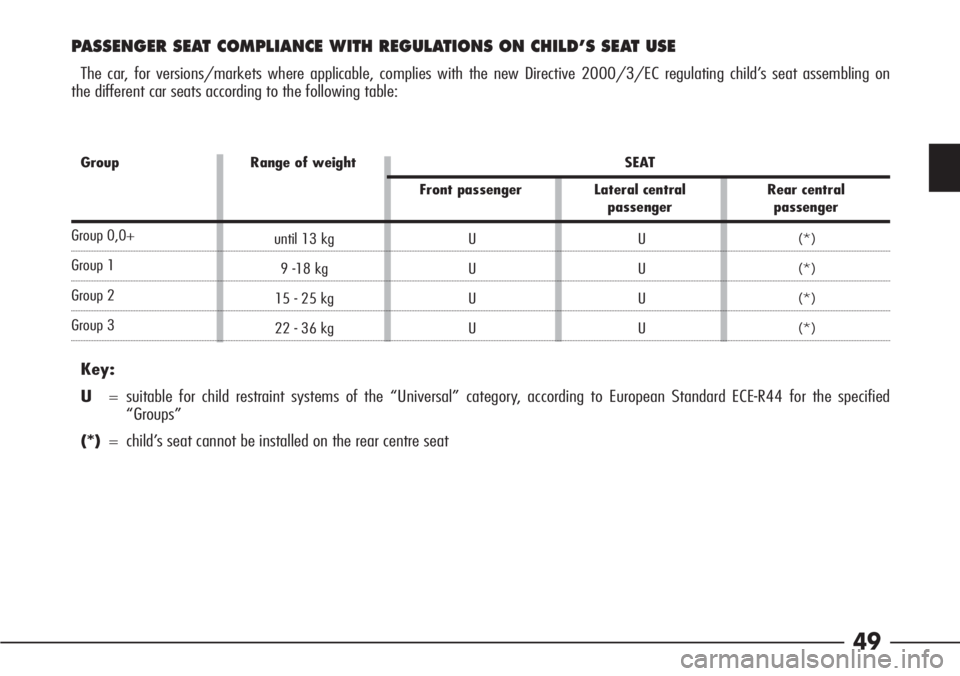
49
PASSENGER SEAT COMPLIANCE WITH REGULATIONS ON CHILD’S SEAT USE
The car, for versions/markets where applicable, complies with the new Directive 2000/3/EC regulating child’s seat assembling on
the different car seats according to the following table:
Key:
U= suitable for child restraint systems of the “Universal” category, according to European Standard ECE-R44 for the specified
“Groups”
(*)= child’s seat cannot be installed on the rear centre seat
Group Range of weight SEAT
Front passenger Lateral central Rear central
passenger passenger
Group 0,0+
Group 1
Group 2
Group 3 until 13 kg
9 -18 kg
15 - 25 kg
22 - 36 kgU
U
U
UU
U
U
U(*)
(*)
(*)
(*)
Page 53 of 272
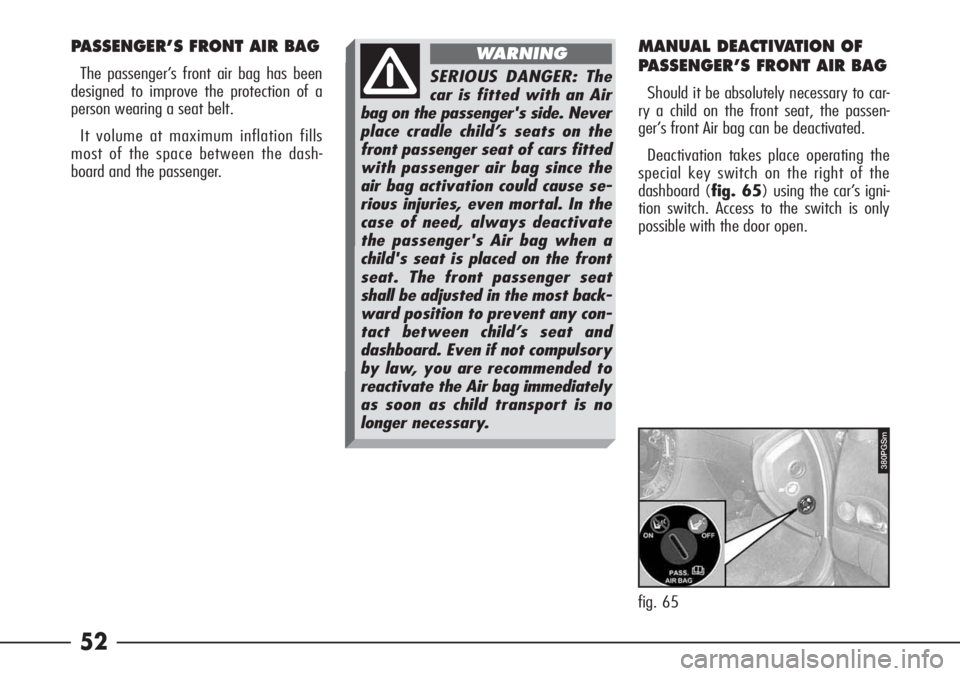
52
PASSENGER’S FRONT AIR BAG
The passenger’s front air bag has been
designed to improve the protection of a
person wearing a seat belt.
It volume at maximum inflation fills
most of the space between the dash-
board and the passenger.
MANUAL DEACTIVATION OF
PASSENGER’S FRONT AIR BAG
Should it be absolutely necessary to car-
ry a child on the front seat, the passen-
ger’s front Air bag can be deactivated.
Deactivation takes place operating the
special key switch on the right of the
dashboard (fig. 65) using the car’s igni-
tion switch. Access to the switch is only
possible with the door open.
SERIOUS DANGER: The
car is fitted with an Air
bag on the passenger's side. Never
place cradle child’s seats on the
front passenger seat of cars fitted
with passenger air bag since the
air bag activation could cause se-
rious injuries, even mortal. In the
case of need, always deactivate
the passenger's Air bag when a
child's seat is placed on the front
seat. The front passenger seat
shall be adjusted in the most back-
ward position to prevent any con-
tact between child’s seat and
dashboard. Even if not compulsory
by law, you are recommended to
reactivate the Air bag immediately
as soon as child transport is no
longer necessary.
WARNING
380PGSm
fig. 65